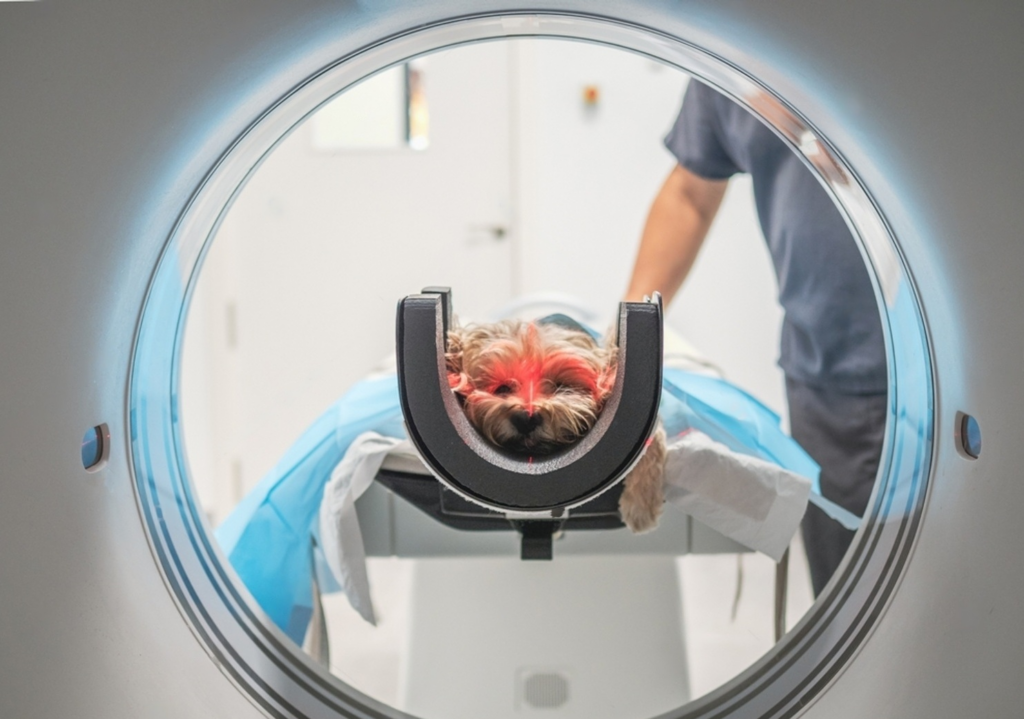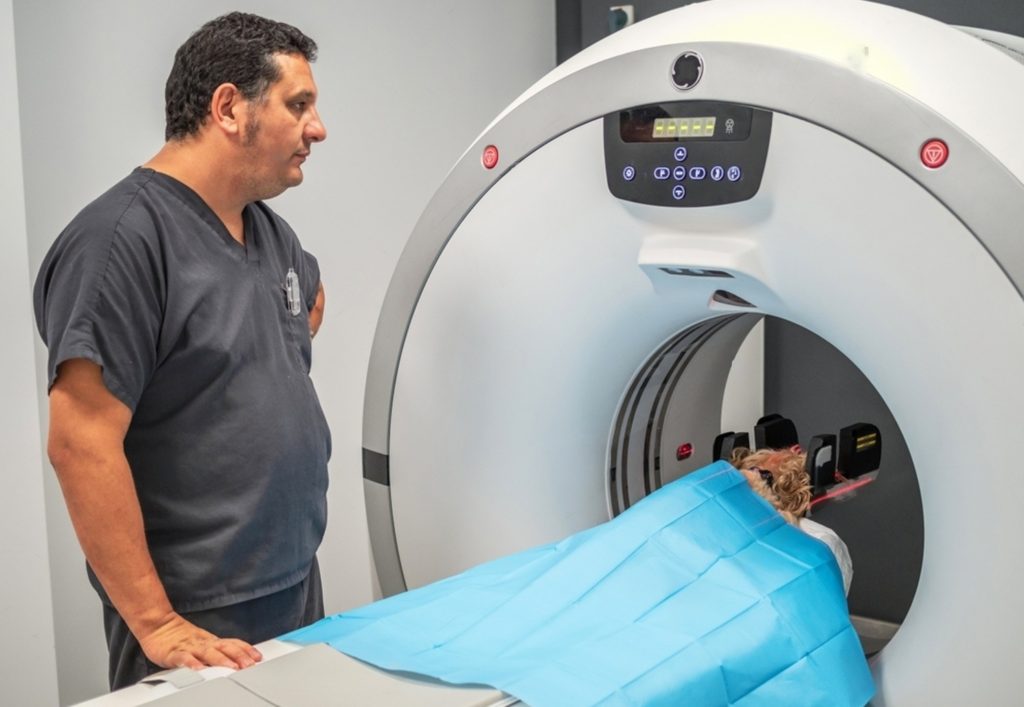A Positron Emission Tomography (PET) scan is a form of medical imaging test that produces comprehensive pictures of the interior structures and functions of the body by making use of a tiny quantity of radioactive material. This test is also known as positron emission tomography. Unlike a regular x-ray, a PET scan may provide information about how effectively your organs are functioning. Those with a proven case of cancer may use them to learn more about the disease’s progression and the efficacy of therapy.
Is it possible to do a PET exam on a companion animal such as a dog?
It is possible to do a PET scan on animals such as dogs and other household pets. In point of fact, PET scans are becoming more popular in the field of veterinary medicine for the purpose of diagnosing and monitoring a wide variety of illnesses that affect animals.
A PET scan performed on an animal follows a method that is quite similar to the one used on a person. A radiotracer is injected into the animal, and it is then taken up by the animal’s organs and tissues throughout its body. After this, the animal is put on a table that slides into the PET scanner. The PET scanner then detects the radiation that is released by the radiotracer and generates detailed, three-dimensional pictures of the region that is being inspected.
Cancer, neurological problems, and cardiovascular illness are among the ailments that may be diagnosed and monitored with the use of PET scans in animals. They may also be used in the process of determining the efficacy of therapies and in the planning stages of surgical operations.
How Does PET Scan Affect Animals?

The effects of a PET scan on an animal may vary depending on the temperament of the particular animal, the sort of sedation or anesthetic used (if any), and the specific ailment that is being diagnosed or monitored during the procedure. PET scans, on the other hand, are not thought to pose any substantial health risks to the animals who undergo them and are widely regarded as safe.
While the injection of the radiotracer itself does not cause any pain, the injection site may cause some animals to suffer moderate discomfort or irritation in rare cases. The radiotracer that is used in PET scans has a short half-life and soon becomes inactive. As a result, the quantity of radiation exposure is extremely minimal and does not represent a substantial health risk to either the animal or the people who care for it.
During the scan, the animal has to be completely motionless in order to provide pictures that are both clear and correct. It’s possible that some animals may handle this without needing to be sedated or given anesthesia, while others might need to be given medicine to help them relax or go to sleep. The use of sedation or anesthesia can include certain dangers, such as respiratory depression or cardiovascular issues, but these risks are normally minor and may be eliminated with the right monitoring and care given to the patient.
Following the scan, the animal may feel some slight side effects from the sedation or anesthesia, such as sleepiness or nausea; however, these symptoms often go away immediately once the scan is through. When it comes to diagnosing or monitoring a severe medical disease in an animal, a PET scan often offers more advantages than it does hazards or possible adverse effects. This is true in most cases.
How exactly does PET scans Work?

In order to perform a PET scan on you, a small amount of radioactive liquid with a short half-life will be injected into your body in the form of a tracer. FDG is the one that is utilized the majority of the time (fluorodeoxyglucose). FDG is a simple sugar; it is glucose that has been radiolabeled. Once inside the body, FDG breaks down into glucose, which then emits energy that can be detected by the scanner.
The rate at which the sugar is absorbed by the tissues of the body is a good indicator of the level of activity present in those tissues. For instance, cancer cells multiply rapidly, which necessitates a great deal of energy and, as a result, a great deal of sugar. Because of this significantly increased consumption of sugar, the scan will show them as bright hot spots.
Because healthy tissue utilizes more sugar than unhealthy tissue does, an area that has a low concentration of tracer may indicate unhealthy tissue or decreased blood flow.
When would it be necessary for me to get a PET scan?
In general, a PET scan can be used to measure essential functions such as blood flow, oxygen consumption, and glucose metabolism in the blood. In addition to this, it is able to determine which organs and tissues are not functioning properly.
A PET scan is able to diagnose cancer as well as detect it, so your healthcare provider will probably suggest getting one if they have any reason to believe you might have cancer.
In the event that you have already been diagnosed with cancer, your healthcare provider may advise you to undergo multiple PET scans throughout the course of your treatment in order to:
- Find out whether cancer has spread to other parts of your body (metastasized).
- Determine how successful the treatment has been.
- After treatment, it is important to check to see if cancer has returned (recurred).
- Conduct a prognostic analysis of the cancer to determine its outlook.
If you are having problems with your heart, your doctor may suggest that you get a PET scan to:
- Determine which areas of your heart have been affected by the heart attack you had.
- Locate the areas of the heart muscle that, if treated with angioplasty or coronary artery bypass surgery, would see an improvement.
If you are having neurological symptoms, your healthcare provider may suggest that you get a PET scan to evaluate any possible brain abnormalities. These abnormalities can include tumors, seizures, and other conditions that affect the central nervous system.
What should I do to get ready for the PET scan?
You should plan to spend between two and three hours in the PET imaging department even though the scan itself only takes about fifteen to twenty minutes on average.
Before the scan, you need to make sure that you:
- Before your scan, make sure you ask if there are any restrictions on what you can eat and drink.
- Bring any previous x-rays or radiology images that you have with you, let the staff know if you are breastfeeding, pregnant, or thinking about becoming pregnant, and let them know if you have diabetes.
- You should let them know if you have a tendency to get anxious when you are in confined spaces.
The procedure for a PET scan is as follows.
As soon as you check in at the medical facility or radiology center, you will be given a gown to change into and instructed to remove all metal and jewelry from your body. Your intravenous line will be inserted into a vein on the back of your hand or arm by the medical staff. After checking the levels of sugar in your blood, the radioactive tracer will be injected into your vein using the intravenous line that is already in place.
After that, you might have to lie down or sit quietly in a chair for the next half an hour. You might be asked to consume some contrast material prior to certain scans. Before the scans begin, you will have the opportunity to urinate normally.
A flat bed that can be slid into a circular opening is featured on the PET scanner. After being placed inside the PET scanner, you will be instructed to maintain the utmost level of stillness as the scans are carried out. If you start to feel claustrophobic, stiff, or uncomfortable, you can let the staff know that you are having these feelings.
How Long Does a PET Scan Take
The scan shouldn’t take any longer than twenty minutes, on average. The staff will examine the images once the scanning is complete. They will take out the intravenous line that you have. After the exam, you need to consume a large amount of water in order to flush the radioactive tracer out of your system. In the event that you are nursing an infant, you will be provided with particular directions.
The scans will be reviewed by a specialist, who will then compose a report for your primary care physician, who will then explain the findings to you.
What are the General potential dangers and negative consequences of getting a PET scan?
In most cases, PET scans are risk-free and only rarely result in complications. Very little radiation can be found in the radioactive tracer due to its low concentration. It does not remain in your body for an extended period of time. After having a PET scan, you will need to drink a lot of water so that the radioactive drug can be flushed out of your body.
PET scans are only known to potentially cause harm in the following circumstances:
- PET scans should not be administered to women who are pregnant, breastfeeding, or breastfeeding. Radiation can be harmful to an unborn child and can be passed on to the child through the mother’s breast milk.
- Some individuals develop an allergic reaction when exposed to the radioactive tracers used in PET scans or the contrast dyes used in CT scans. These types of allergic reactions happen hardly ever and are typically not severe. In the event that this response occurs, the medical staff that is caring for you can give you medication to quickly mitigate and stop it.
- People who have diabetes may have trouble absorbing the sugar contained in the radiotracer, which can have an impact on the results of the scan. Before the test, your healthcare provider will give you recommendations about how to adjust both your diet and your medication.

